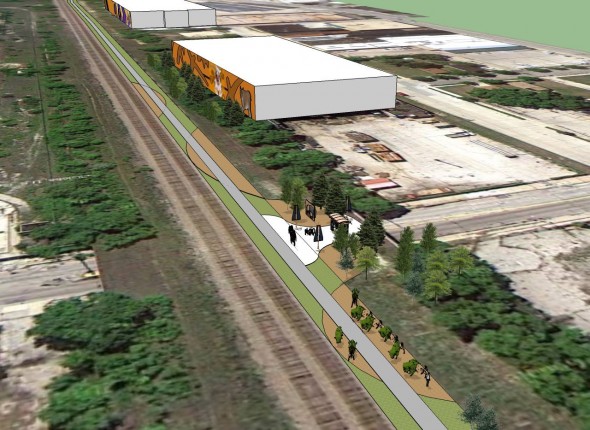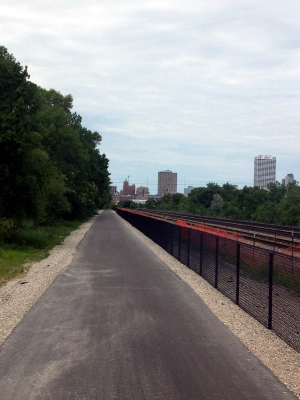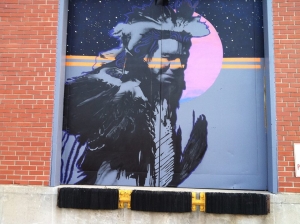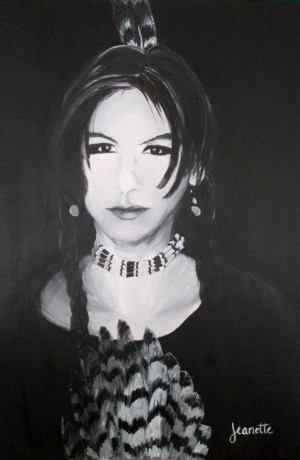Where the Buffalo Roam
A new art project honoring Native American history will be constructed on the new Downtown to Bay View Bikeway

Native American Awareness Project Rendering. Rendering by Mark David Gray.

Trail facing North toward Downtown. Photo by Joe Kelly.
It could quite a sight for train passengers heading south: a series of life-size steel buffalo sculptures along the Downtown to Bay View Bikeway. “Anyone riding the Amtrak to Chicago will see the art out their window,” says John Cook, Executive Director of the Native American Awareness Project. The buffalo will be part of phase one in a two-phase Native American art installation project proposed for construction along the newly-paved bike trail.
The new trail, more than a mile long, runs from just east of Barclay St. on Washington St. and the south entrance is on Maple St. just east of Kinnickinnic Ave. and mostly runs along the train tracks. The trail is part of an effort to reclaim the KK River and make it more accessible and more of a recreational amenity.
Cook, a member of the Oneida Indian Tribe, says the art project has been on his mind for a while. The opportunity became more feasible when the Native American Awareness Project joined with Milwaukee’s local Satellite Gallery Project. The two organizations are now working in tandem on this project.
Nolan Peck is a Co-Founder of the Satellite Gallery Project and one of the Lead Artist Coordinators for the installation. “The Satellite Gallery Project basically looks for vacant spaces and rooms to use so that local, under-recognized artists can get their work out in the community,” he says. Peck first met Cook back in April at the Hide House in Bay View, and they have been excited about the art project ever since.

Mural by Mark David Gray. Photo courtesy of John Cook.
The project’s first phase will include the life-size steel buffalo sculptures dotting the beginning, middle, and end of the trail. These will be filled with various plants and biomass to give them the appearance of buffalo-shaped topiary. The first few are planned to be manufactured at the Milwaukee Makerspace.
Also part of the project: Native History Murals will be painted on the faces of two of the buildings lining the bike trail. The murals will depict the history of Native American culture in the Milwaukee area dating from the early 1500’s up to the modern era.
Jeanette Fellows is one of the lead artists for the murals. Fellows, who met John Cook through an ART Milwaukee Jamboree, says she immediately gravitated to the project, since she’s a member of the Akimel O’Odham, or Pima, Tribe from the Gila River Indian Community. “The idea of a project with a strong Native American connection hit close to the heart for me,” she says. The project has the wholehearted support of several Native American Elders and the local Native American community.

Portrait by Jeanette Fellows. Photo courtesy of John Cook.
Other planned installations in phase one are rain gardens (which also reduce stormwater runoff) and bike shelters. These bike shelters will be powered via solar cell systems which will keep them lit for use in the evening and early nighttime. The bike shelters will also have QR codes that will not only provide information on Native American history and culture, including language translations and stories told by Native American Elders, but will also advertise local food and business destinations within proximity of the bike trail. Cook hope is that the QR advertising funds will help pay for the topiaries and also help fund trail maintenance.
The ambitious project is still in its infancy, meaning funding and financial backing is still in the process of being secured, so the QR advertising is important. Jamie Gierczak, another Co-Founder and Head of Administration for the Milwaukee Satellite Gallery Project, says “We hope various organizations will help fund this project.” One plan, she notes, is to sell sponsorships for the herds of topiary buffalo, so each is sponsored by local organizations and businesses. “We are also in the process of writing grants for the Wisconsin Arts Board and The Milwaukee Satellite Galleries will hold fundraising events as well,” she adds.
“By the end of August, we plan to have the first herd of buffalo going up,” Gierczak says. “After that, we plan on starting the first set of murals in the fall.” She expects the project will take three years to complete.
The Native American Awareness Project and the Milwaukee Satellite Gallery Project have come together to create art installations that will help to better illustrate the Native American roots in the bedrock of Milwaukee’s history and culture. According to 2012 census estimates, 0.9% of the 1.1% of Wisconsinites who are American Indian or Alaska Native live in Milwaukee County, so this area remains the heart of their cultural presence.
The installation of the buffalo near the railroad track, where the chugging, rolling sound of the Amtrak can be heard, brings another image to mind for Cook. “The sound of the train going by will somewhat mirror the sound of a herd of buffalo,” he says. By the end of the summer, those herds may be metaphorically stampeding onto the KK bike trail.





















Love this.
The sound of the Amtrak rolling by, rather than sounding similar to thundering herds of buffalo, should, if you pay attention to facts, remind viewers of the final decimation of those herds, accomplished by “hunters” who rode the rails west and slaughtered thousands of the beasts en route. It must have been an easy shot from the interior of the train.
My thoughts exactly judith
I am truly in favor of Native American Art. There were no Buffalo in the Milwaukee area.
Does everyone but me know what QR is?
your thoughts about “no buffalo” in Milwaukee area is a sharp shot. Now about the “topiary” appearance of the proposed steel buffalo sculptures. What is the point of that idea pray tell?
Topiary is a distinctly European approach. Why not scuttle the “art” portions (sculptures, murals) and use that effort to beautiful the trail with native plantings.?Take a look at what’s been accomplished at the Lakeshore State Park…And as long as I’m thinking, murals often end up orphaned,” (like some of the Riverwalk sculptures)..peeling crumbling images, that seen from Amtrak, are dismal…
Well written article. Good for Milwaukee for initiating this project.
Beautifully written article about an amazing project
Nice complement to the bike trail I think.
First of all I pick Buffalo because they are a cooler then T.P. and thanks to western movie .people think Native American when they see them .second of all unlike any other public art done any where we are taking charge of the up keep and maintain of this project.
so to the uniform Ms. who want to hate on Native understand this .The Native American Awareness project is about just that .get MY PEOPLE a voice in the city of Milwaukee . The urban Native is not a urban Myth .WE are here and we have been here before any one else and will be here long after every one else is gone .Thew word Milwaukee means gathering place check your history the form of gov used by this country came from My people, the right for women to vote also one of ours .
thank you for your time
I would like to meet with Ms. Judith .Me and a few Native American to talk about our history .
and what we are doing . It very easy to sit be hide a key broad and say stuff . let meet and you can tell us all what you think about Native Americans and our art .face to face ..and for the record
Buffalo covered north American .Its just one more thing that did not make your history books .
But i am sure you know this because your Family history pre dates the us !
oh and bring Gerard to so we can hear him to !
Well written Joe, interesting piece